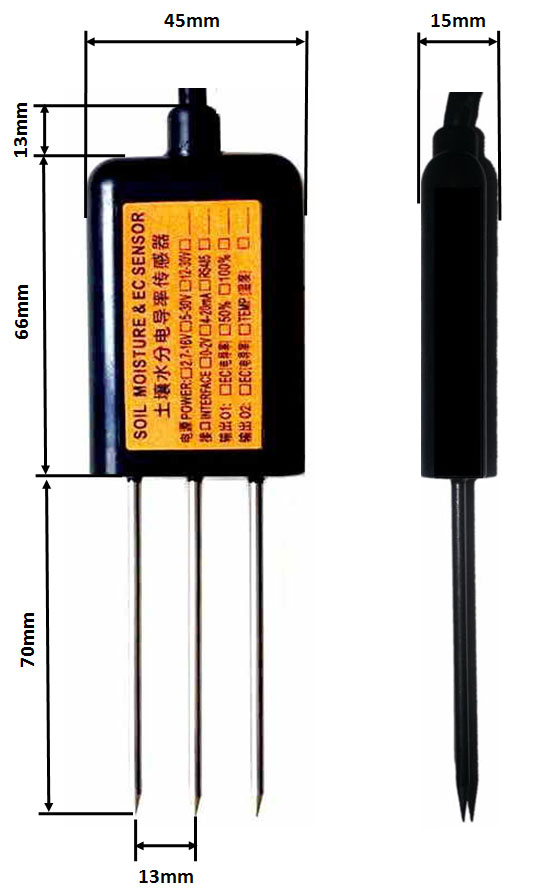Meteorological environment monitoring equipment supplier
Insist on doing high-precision customer favorite technology products

1. Product introduction of soil temperature, moisture and salinity sensor
Soil temperature, moisture and salinity sensor is also called soil temperature, humidity and salt sensor, soil temperature, humidity and salinity sensor. The soil temperature, moisture and salinity sensor is used for soil moisture content, electrical conductivity and temperature monitoring. The actual moisture content of the soil. FT-WSY485 soil temperature, moisture and salinity sensor has stable performance and high sensitivity. It is an important tool for observing and studying the occurrence, evolution, improvement and water-salt dynamics of saline soil. The soil moisture sensor can measure the volume percentage of soil moisture, which is a soil moisture measurement method in line with current international standards. It is suitable for soil moisture monitoring, scientific experiments, water-saving irrigation, greenhouses, flowers and vegetables, grass pastures, soil quick measurement, plant cultivation, sewage treatment, precision agriculture and other occasions.
2. The soil temperature, moisture and salinity sensor has the following characteristics:
(1) The three parameters of soil moisture content, electrical conductivity and temperature are integrated into one.
(2) It can also be used for the conductivity of water and fertilizer integrated solutions, as well as other nutrient solutions and substrates.
(3) The electrodes are made of specially treated alloy materials, which can withstand strong external shocks and are not easily damaged.
(4) Completely sealed, resistant to acid and alkali corrosion, can be buried in soil or directly put into water for long-term dynamic detection.
(5) High precision, fast response, good interchangeability, probe insertion design to ensure accurate measurement and reliable performance.
Technical Parameters | |
Signal output type | RS485 interface Modbus protocol |
supply voltage | 3.6-30V/DC DC |
Static power | 6mA@24V DC DC |
Soil moisture range | Optional range: 0-50%, 0-100% Resolution: 0.03% within 0-50%, 1% within 50-100% Accuracy: 2% within 0-50%, 3% within 50-100% |
Conductivity range | Optional range: 0-20000us/cm Resolution: 10us/cm within 0-10000us/cm, 50us/cm within 100000-20000us/cm Accuracy within the range of 0-10000us/cm is ±3%; within the range of 10000-20000us/cm is ±5% |
Conductivity temperature compensation | Built-in temperature compensation sensor, compensation range 0-50°C |
Temperature measurement range | Range: -40~80°C, Resolution: 0.1°C, Accuracy: ±0.5°C |
Measuring principle and measuring method | Soil Moisture FDR Method, Soil Conductivity AC Bridge Method In-situ insertion or immersion of the soil into the culture solution, water and fertilizer integrated nutrient solution for direct testing |
degree of protection | IP68 immersion in water can be used for a long time |
operating environment | -40~85℃ |
Probe material | Anti-corrosion special electrode |
Sealing material | Black Flame Retardant Epoxy |
installation method | All buried or all probes inserted into the measured medium |
Default Cable Length | 2 meters, cable length can be customized |
connection method | Pre-installed cold-pressed terminals |
Dimensions | 45*15*145mm |
electrode length | 70mm |
3. Soil temperature, moisture and salinity sensor wiring
model | wiring diagram |
RS485 interface type Modbus protocol |
Red (V+): Power supply is positive Black (G): power ground Yellow(T+): RS485+/A/T+ White(T-): RS485-/B/T-
|
4. Dimensions, selection and ordering of soil temperature, moisture and salinity sensors

5. Installation and measurement of soil temperature, moisture and salinity sensors
Since the electrode directly measures the conductivity of the soluble salt ions in the soil, the soluble ions in the soil must be higher than about 20% when the soil volume moisture content can correctly reflect the conductivity of the soil. In the long-term observation, the measured value after irrigation or rainfall is closer to the true level. If you want to measure quickly, you can water the measured soil first, and measure after the water is fully infiltrated.
(1) Quick measurement method: select a suitable measurement location, avoid stones, ensure that the electrode will not touch hard objects such as stones, dig the surface soil according to the required measurement depth, and maintain the original tightness of the soil below , Hold the sensor body firmly and insert it into the soil vertically. When inserting, do not shake it back and forth, left and right, to ensure close contact with the soil. It is recommended to measure multiple times in a small range of a measuring point to obtain the average.
(2) Buried measurement method: According to the required depth, vertically dig a pit with a diameter greater than 20 cm. The depth is according to the measurement requirements, and then insert the sensor steel needle horizontally into the pit wall at the predetermined depth, and fill the pit. soil in close contact. After a period of stability, it can be measured and recorded for several days, months or even longer.
If you are measuring on a hard surface, you should drill a hole first (the diameter of the hole should be smaller than the diameter of the probe), then insert it into the soil and compact the soil before measuring; the sensor should prevent severe vibration and impact, let alone hit it with hard objects. Since the sensor is packaged in black, the temperature of the sensor will rise sharply (up to 50°C) under strong sunlight. In order to prevent excessive temperature from affecting the temperature measurement of the sensor, please pay attention to sunshade and protection when using it in the field or in the field. .
6. Soil temperature, moisture and salinity sensor Soil conductivity, temperature and output conversion
model | parameter range | Conversion relationship |
RS485 interface Modbus protocol | Corresponding moisture content 0-100%
| Moisture rate = Moisture rate register value/100. If the read data is 2013, then the moisture content = 2013/100=20.13%. |
Corresponding temperature -40-80℃
| Temperature = temperature register value/100. If the read data is 2013, then temperature = 2013/100=20.13°C. | |
Corresponding conductivity
| Conductivity = Conductivity register value. If the read data is 1568, then the conductivity = 1568us/cm. |